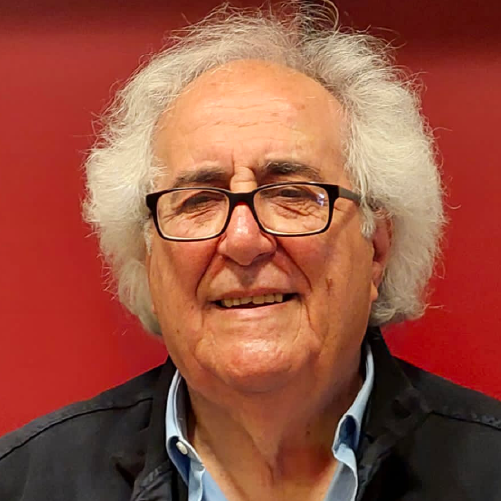

The Public Art Gallery
The Public Art Gallery
Riproduci traccia audio
Play audio track
Audio-Track abspielen
The Public Art Gallery
Trascrizione traccia audio
Looking at this building you would not believe how many different uses this building has had.
It was built in 1929 to house the city’s first wholesale fish market. The architectural structure today is the same as the original one, with the only difference that before it was an open structure without windows and only the colonnade supported the roof and its gates. The boats arrived at the entrance on the canal side, docked and unloaded their fish. In those days most people were still sailing traditional vessels and you could count the motorised fishing boats on the fingers of one hand.
When the new fish market was built in 1950 on the other side of the canal in the west of town, this building became Cesenatico’s first supermarket.
In the 1960s it changed its use again and was transformed into an exhibition space, aptly named the Public Art Gallery.
Since 2015, when it was last restored, the Gallery has had a busy calendar of exhibitions. Prior to that however it was largely left empty and used only when important events were happening in town, such as the celebrations for Garibaldi day, and the visit of Spadolini (a former Italian prime minister). I also remember events organised to commemorate 25 April and 20 October, the dates of the National liberation from Nazi-fascism and also that of Cesenatico’s liberation, two fixed annual events for us: other important exhibitions were created in partnership with schools at all levels and also with the Committee for the Defence of Anti-Fascist Democratic Institutions. Between the Seventies and the Nineties, the Gallery began to become an important landmark.
Exhibitions took place mainly in the summer period. At other times of the year, this was also the place where the elderly would meet for get togethers in this centrally located, accessible and also comfortable location with 100 seats, they were happy not to have to navigate stairs!.
Just outside, on the benches near the bust of Anita Garibaldi, that were once upon a time arranged in a different manner, “the G7” met: this was the light-hearted name that a group of elderly people had given themselves, aware that they represented those that could preserve the memories of Cesenatico. Morning and afternoon, they sat here sharing memories and discussing the news of the day.
If I think of the many changes that this place has undertaken, I cannot help but remember what the whole town has gone through in the space of a few decades.
When the town was very quiet, motorcycle races would be organised over the Easter holidays, to hail the start of the summer season. One of the first upmarket projects was named “the Bittersweet Prize”. It held centre stage in celebrity gossip news during 1963 and 1964: the idea was to award the “sweetest” or “most miserable” showbiz characters in their interaction with the wider public and with the press. The cream of Italian Artists such as Amedeo Nazzari, Virna Lisi, Sandra Milo, Walter Chiari, Gastone Moschin… were accommodated at the Grand Hotel and articles for the tabloid press were fueled! Both the national and international reputation of Cesenatico began to grow visibly.
From 1965 to 1971 it was the turn of Football Trials, a brilliant event created by Count Rognoni, who in those years was a well-recognised character in the sports press.
In the sixties and seventies, the official organisation that looked after the promotion of tourism was called the Azienda di Soggiorno. Primo Grassi, one of its directors, was a real driving force: famously after the influx of some strange looking seaweed washed up on the shore, he drank a glass of sea water just to demonstrate to the tourists that the water was safe, and it was fine to swim in.
Another well-known personality was Giorgio Ghezzi, former goalkeeper for Inter, Milan and Genoa who, after finishing his football career, became an entrepreneur in tourism. To Cesenatico he was the Pantani of the time (referring to Marco Pantani, the cyclist from Cesenatico who won the Tour de France and Giro d’Italia). Ghezzi was a man who gave worldwide fame to this town. During the Sixties: he owned the Peccato Veniale nightclub and the Internazionale hotel, so named to honor his favorite football team (Inter). Over the years, many of his former teammates visited him, helping to establish Cesenatico’s fame as an exclusive social destination: We welcomed players such as Altafini, Rivera and Suarez.
We have put a tourist destination on the map where it did not exist before. Initiatives take place such as the annual Nativity scene set on the antique boats in the port, this gives us identity and draws attention to our Maritime Museum and its antique exhibits. We have held important shows, at the School on via saffi, in the heart of the town, memorable presentations dedicated to famous people such as the Nobel Prize Winner, Dario Fo, Carlo Carrà and Bruno Munari. I also think of the Vena Mazzarini Canal where once there was an outdoor dolphinarium, a unique attraction during the sixties in Cesenatico, another great initiative by the tourist board.
There has always been steady growth here, including this building which has gradually transformed into the space we see today: a place dedicated to hosting small exhibitions, limited by its space, but which are significant, especially for local artists.
The Public Art Gallery has always been a place that moved with the times and so it will stay for years to come. As we move forward in the future more cultural space is needed so that we have the opportunity to permanently display works owned by the Council and donated over time by public figures such as Tono Zancanaro, Tinin Mantegazza and Giovanni Bissoni, our beloved ex-mayor who recently passed away.
The restoration of the Gallery in 2015 was a way of giving new dignity to an important place for the town, but it is only one stage of a journey that we hope will take us even further…
Audio Track transcription
Looking at this building you would not believe how many different uses this building has had.
It was built in 1929 to house the city’s first wholesale fish market. The architectural structure today is the same as the original one, with the only difference that before it was an open structure without windows and only the colonnade supported the roof and its gates. The boats arrived at the entrance on the canal side, docked and unloaded their fish. In those days most people were still sailing traditional vessels and you could count the motorised fishing boats on the fingers of one hand.
When the new fish market was built in 1950 on the other side of the canal in the west of town, this building became Cesenatico’s first supermarket.
In the 1960s it changed its use again and was transformed into an exhibition space, aptly named the Public Art Gallery.
Since 2015, when it was last restored, the Gallery has had a busy calendar of exhibitions. Prior to that however it was largely left empty and used only when important events were happening in town, such as the celebrations for Garibaldi day, and the visit of Spadolini (a former Italian prime minister). I also remember events organised to commemorate 25 April and 20 October, the dates of the National liberation from Nazi-fascism and also that of Cesenatico’s liberation, two fixed annual events for us: other important exhibitions were created in partnership with schools at all levels and also with the Committee for the Defence of Anti-Fascist Democratic Institutions. Between the Seventies and the Nineties, the Gallery began to become an important landmark.
Exhibitions took place mainly in the summer period. At other times of the year, this was also the place where the elderly would meet for get togethers in this centrally located, accessible and also comfortable location with 100 seats, they were happy not to have to navigate stairs!.
Just outside, on the benches near the bust of Anita Garibaldi, that were once upon a time arranged in a different manner, “the G7” met: this was the light-hearted name that a group of elderly people had given themselves, aware that they represented those that could preserve the memories of Cesenatico. Morning and afternoon, they sat here sharing memories and discussing the news of the day.
If I think of the many changes that this place has undertaken, I cannot help but remember what the whole town has gone through in the space of a few decades.
When the town was very quiet, motorcycle races would be organised over the Easter holidays, to hail the start of the summer season. One of the first upmarket projects was named “the Bittersweet Prize”. It held centre stage in celebrity gossip news during 1963 and 1964: the idea was to award the “sweetest” or “most miserable” showbiz characters in their interaction with the wider public and with the press. The cream of Italian Artists such as Amedeo Nazzari, Virna Lisi, Sandra Milo, Walter Chiari, Gastone Moschin… were accommodated at the Grand Hotel and articles for the tabloid press were fueled! Both the national and international reputation of Cesenatico began to grow visibly.
From 1965 to 1971 it was the turn of Football Trials, a brilliant event created by Count Rognoni, who in those years was a well-recognised character in the sports press.
In the sixties and seventies, the official organisation that looked after the promotion of tourism was called the Azienda di Soggiorno. Primo Grassi, one of its directors, was a real driving force: famously after the influx of some strange looking seaweed washed up on the shore, he drank a glass of sea water just to demonstrate to the tourists that the water was safe, and it was fine to swim in.
Another well-known personality was Giorgio Ghezzi, former goalkeeper for Inter, Milan and Genoa who, after finishing his football career, became an entrepreneur in tourism. To Cesenatico he was the Pantani of the time (referring to Marco Pantani, the cyclist from Cesenatico who won the Tour de France and Giro d’Italia). Ghezzi was a man who gave worldwide fame to this town. During the Sixties: he owned the Peccato Veniale nightclub and the Internazionale hotel, so named to honor his favorite football team (Inter). Over the years, many of his former teammates visited him, helping to establish Cesenatico’s fame as an exclusive social destination: We welcomed players such as Altafini, Rivera and Suarez.
We have put a tourist destination on the map where it did not exist before. Initiatives take place such as the annual Nativity scene set on the antique boats in the port, this gives us identity and draws attention to our Maritime Museum and its antique exhibits. We have held important shows, at the School on via saffi, in the heart of the town, memorable presentations dedicated to famous people such as the Nobel Prize Winner, Dario Fo, Carlo Carrà and Bruno Munari. I also think of the Vena Mazzarini Canal where once there was an outdoor dolphinarium, a unique attraction during the sixties in Cesenatico, another great initiative by the tourist board.
There has always been steady growth here, including this building which has gradually transformed into the space we see today: a place dedicated to hosting small exhibitions, limited by its space, but which are significant, especially for local artists.
The Public Art Gallery has always been a place that moved with the times and so it will stay for years to come. As we move forward in the future more cultural space is needed so that we have the opportunity to permanently display works owned by the Council and donated over time by public figures such as Tono Zancanaro, Tinin Mantegazza and Giovanni Bissoni, our beloved ex-mayor who recently passed away.
The restoration of the Gallery in 2015 was a way of giving new dignity to an important place for the town, but it is only one stage of a journey that we hope will take us even further…
Audiotrack-Text
Looking at this building you would not believe how many different uses this building has had.
It was built in 1929 to house the city’s first wholesale fish market. The architectural structure today is the same as the original one, with the only difference that before it was an open structure without windows and only the colonnade supported the roof and its gates. The boats arrived at the entrance on the canal side, docked and unloaded their fish. In those days most people were still sailing traditional vessels and you could count the motorised fishing boats on the fingers of one hand.
When the new fish market was built in 1950 on the other side of the canal in the west of town, this building became Cesenatico’s first supermarket.
In the 1960s it changed its use again and was transformed into an exhibition space, aptly named the Public Art Gallery.
Since 2015, when it was last restored, the Gallery has had a busy calendar of exhibitions. Prior to that however it was largely left empty and used only when important events were happening in town, such as the celebrations for Garibaldi day, and the visit of Spadolini (a former Italian prime minister). I also remember events organised to commemorate 25 April and 20 October, the dates of the National liberation from Nazi-fascism and also that of Cesenatico’s liberation, two fixed annual events for us: other important exhibitions were created in partnership with schools at all levels and also with the Committee for the Defence of Anti-Fascist Democratic Institutions. Between the Seventies and the Nineties, the Gallery began to become an important landmark.
Exhibitions took place mainly in the summer period. At other times of the year, this was also the place where the elderly would meet for get togethers in this centrally located, accessible and also comfortable location with 100 seats, they were happy not to have to navigate stairs!.
Just outside, on the benches near the bust of Anita Garibaldi, that were once upon a time arranged in a different manner, “the G7” met: this was the light-hearted name that a group of elderly people had given themselves, aware that they represented those that could preserve the memories of Cesenatico. Morning and afternoon, they sat here sharing memories and discussing the news of the day.
If I think of the many changes that this place has undertaken, I cannot help but remember what the whole town has gone through in the space of a few decades.
When the town was very quiet, motorcycle races would be organised over the Easter holidays, to hail the start of the summer season. One of the first upmarket projects was named “the Bittersweet Prize”. It held centre stage in celebrity gossip news during 1963 and 1964: the idea was to award the “sweetest” or “most miserable” showbiz characters in their interaction with the wider public and with the press. The cream of Italian Artists such as Amedeo Nazzari, Virna Lisi, Sandra Milo, Walter Chiari, Gastone Moschin… were accommodated at the Grand Hotel and articles for the tabloid press were fueled! Both the national and international reputation of Cesenatico began to grow visibly.
From 1965 to 1971 it was the turn of Football Trials, a brilliant event created by Count Rognoni, who in those years was a well-recognised character in the sports press.
In the sixties and seventies, the official organisation that looked after the promotion of tourism was called the Azienda di Soggiorno. Primo Grassi, one of its directors, was a real driving force: famously after the influx of some strange looking seaweed washed up on the shore, he drank a glass of sea water just to demonstrate to the tourists that the water was safe, and it was fine to swim in.
Another well-known personality was Giorgio Ghezzi, former goalkeeper for Inter, Milan and Genoa who, after finishing his football career, became an entrepreneur in tourism. To Cesenatico he was the Pantani of the time (referring to Marco Pantani, the cyclist from Cesenatico who won the Tour de France and Giro d’Italia). Ghezzi was a man who gave worldwide fame to this town. During the Sixties: he owned the Peccato Veniale nightclub and the Internazionale hotel, so named to honor his favorite football team (Inter). Over the years, many of his former teammates visited him, helping to establish Cesenatico’s fame as an exclusive social destination: We welcomed players such as Altafini, Rivera and Suarez.
We have put a tourist destination on the map where it did not exist before. Initiatives take place such as the annual Nativity scene set on the antique boats in the port, this gives us identity and draws attention to our Maritime Museum and its antique exhibits. We have held important shows, at the School on via saffi, in the heart of the town, memorable presentations dedicated to famous people such as the Nobel Prize Winner, Dario Fo, Carlo Carrà and Bruno Munari. I also think of the Vena Mazzarini Canal where once there was an outdoor dolphinarium, a unique attraction during the sixties in Cesenatico, another great initiative by the tourist board.
There has always been steady growth here, including this building which has gradually transformed into the space we see today: a place dedicated to hosting small exhibitions, limited by its space, but which are significant, especially for local artists.
The Public Art Gallery has always been a place that moved with the times and so it will stay for years to come. As we move forward in the future more cultural space is needed so that we have the opportunity to permanently display works owned by the Council and donated over time by public figures such as Tono Zancanaro, Tinin Mantegazza and Giovanni Bissoni, our beloved ex-mayor who recently passed away.
The restoration of the Gallery in 2015 was a way of giving new dignity to an important place for the town, but it is only one stage of a journey that we hope will take us even further…
Narrato da
Narrated by
Mehr Infos



